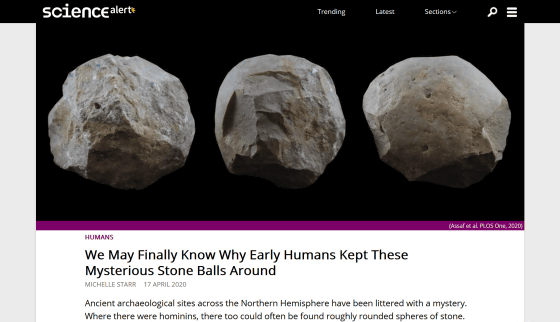It turned out what the mysterious 'spherical stone' made by human beings 2 million years ago was used for

by Isabella Caricola; Assaf E. et al
It is known that Paleolithic humans have been making 'palm-sized spherical stones' for two million years, and stones of similar shape have been found in ruins in Africa, Europe, and Asia. It was not clear what purpose this spherical stone was used for, but an Israeli research team announced that it had a 'can opener' role.
Shaped stone balls were used for bone marrow extraction at Lower Paleolithic Qesem Cave, Israel
Mystery of 2-million-year-old stone balls solved | Live Science
https://www.livescience.com/ancient-stone-balls-bone-marrow.html
We May Finally Know Why Early Humans Kept These Mysterious Stone Balls Around
https://www.sciencealert.com/archaeologists-may-have-figured-out-the-purpose-of-mysterious-prehistoric-stone-balls

Paleolithic ruins in the northern hemisphere often contain 'spherical stones,' some of which are known to have been made by humans more than two million years ago. However, it seems that spherical stones could not be made last hundreds of thousands of years ago, and modern researchers could not know what purpose the spherical stones were used.
Meanwhile, a research team of

by Ella Assaf; Assaf E. et al
Researchers point out that spherical stones were made by a very old technique compared to other stone tools found in the Kesem cave. Humans lived in the Kesem cave between 400,000 and 200,000 years ago, but no new spherical stones have been discovered in the region east of the Mediterranean Sea than in the Kesem cave.
Also, of the 30 stones, one is
It is said that all the stones were not perfectly spherical, and there were sharply protruding parts left on the surface, and 10 pieces were found to have traces of wear and residue due to use. Therefore, when the research team analyzed the surface of the stone tool with a digital stereoscopic microscope etc. in cooperation with the University of Rome La Sapienza in Italy, the compactness and sponge quality , collagen fiber, animal fat etc. that compose the bone of the animal were found. It was. Especially, it seems that traces of organic matter were prominently seen on the part protruding from the surface, and the research team thought that the spherical stone was 'used to crush bones of animals and eat bone marrow inside'.
In addition, the research team crushed various types of rocks, creating stones of the same shape as found at the ruins. Using this stone replica and natural stones to crush cows and sheep and investigate whether spherical stones actually help to remove bone marrow. As a result, the rugged spherical stone was easy to grasp, and the protruding parts were convenient for breaking bones, and it was possible to take out the bone marrow cleanly and eat it. The wear marks left on the replica stone after breaking the bone were very similar to those found in the Kesem cave, Assaf said.

by Ella Assaf; Assaf E. et al
Bone marrow contains a large amount of fatty acids in the body of animals, and it was a very important nutrient source for humans in the early Paleolithic period. 'Our research provided the first evidence of the function of these mysterious spherical stones,' said Assaf Cave Residents, who used spherical stones to remove bone marrow from animal bones. Claimed to have used.
This result is consistent with another study by the team studying the Kesem cave in 2019, saying that `` human beings living in the Kesem cave used the bone marrow of animals as a'preserved food '' '. I will. In this study, it was pointed out that the bone was used as a 'can' to store the bone marrow, and the spherical stone used to remove the bone marrow had a 'can opener' role.
Prehistoric humans used `` animal bone marrow '' as a preserved food-GIGAZINE

by Dr. Ruth Blasco / AFTAU
Related Posts:
in Science, Posted by log1h_ik






